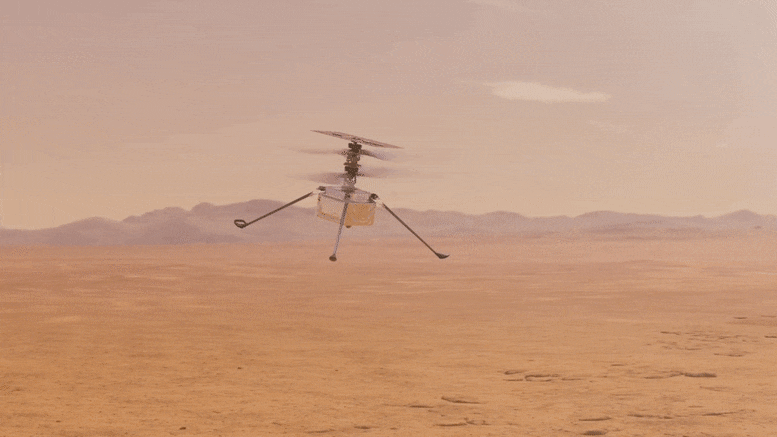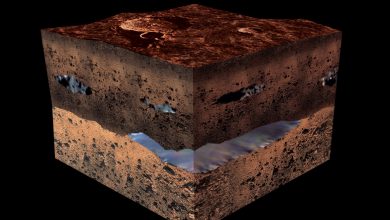
Lead Image: NASA Mars Helicopter Ingenuity illustration. Credit: NASA/JPL
Recently downlinked imagery of a September flight has allowed the rover imaging team to put together a video of rotorcraft performing to near-perfection.
Video footage from NASA’s Perseverance Mars rover of the Ingenuity Mars Helicopter’s 13th flight on September 4 provides the most detailed look yet of the rotorcraft in action.
Ingenuity is currently prepping for its 16th flight, scheduled to take place no earlier than Saturday, November 20, but the 160.5-second Flight 13 stands out as one of Ingenuity’s most complicated. It involved flying into varied terrain within the “Séítah” geological feature and taking images of an outcrop from multiple angles for the rover team. Acquired from an altitude of 26 feet (8 meters), the images complement those collected during Flight 12, providing valuable insight for Perseverance scientists and rover drivers.
Video from the Mastcam-Z instrument aboard NASA’s Perseverance Mars rover captures a close-up view of the 13th flight of the agency’s Ingenuity Mars Helicopter, on September 4, 2021. Credit: NASA/JPL-Caltech/ASU/MSSS
Captured by the rover’s two-camera Mastcam-Z, one video clip of Flight 13 shows a majority of the 4-pound (1.8-kilogram) rotorcraft’s flight profile. The other provides a closeup of takeoff and landing, which was acquired as part of a science observation intended to measure the dust plumes generated by the helicopter.
“The value of Mastcam-Z really shines through with these video clips,” said Justin Maki, deputy principal investigator for the Mastcam-Z instrument at NASA’s Jet Propulsion Laboratory in Southern California. “Even at 300 meters [328 yards] away, we get a magnificent closeup of takeoff and landing through Mastcam-Z’s ‘right eye.’ And while the helicopter is little more than a speck in the wide view taken through the ‘left eye,’ it gives viewers a good feel for the size of the environment that Ingenuity is exploring.”
During takeoff, Ingenuity kicks up a small plume of dust that the right camera, or “eye,” captures moving to the right of the helicopter during ascent. After its initial climb to planned maximum altitude of 26 feet (8 meters), the helicopter performs a small pirouette to line up its color camera for scouting. Then Ingenuity pitches over, allowing the rotors’ thrust to begin moving it horizontally through the thin Martian air before moving offscreen. Later, the rotorcraft returns and lands in the vicinity of where it took off. The team targeted a different landing spot – about 39 feet (12 meters) from takeoff – to avoid a ripple of sand it landed on at the completion of Flight 12.
Video footage from the Mastcam-Z instrument aboard NASA’s Perseverance Mars rover provides a big-picture perspective of the 13th flight of the agency’s Ingenuity Mars Helicopter, on September 4, 2021. Credit: NASA/JPL-Caltech/ASU/MSSS
Though the view from Mastcam-Z’s left eye shows less of the helicopter and more of Mars than the right, the wide angle provides a glimpse of the unique way that the Ingenuity team programmed the flight to ensure success.
“We took off from the crater floor and flew over an elevated ridgeline before dipping into Séítah,” said Ingenuity Chief Pilot Håvard Grip of JPL. “Since the helicopter’s navigation filter prefers flat terrain, we programmed in a waypoint near the ridgeline, where the helicopter slows down and hovers for a moment. Our flight simulations indicated that this little ‘breather’ would help the helicopter keep track of its heading in spite of the significant terrain variations. It does the same on the way back. It’s awesome to actually get to see this occur, and it reinforces the accuracy of our modeling and our understanding of how to best operate Ingenuity.”
The wide-angle view also shows how Ingenuity maintains altitude during the flight. After an initial ascent to 26 feet (8 meters) altitude, the helicopter’s laser altimeter notes a change in elevation of the terrain below as it heads northeast toward the ridgeline. Ingenuity automatically adjusts, climbing slightly as it approaches the ridge and then descending to remain 26 feet (8 meters) above the undulating surface. Once it flies to the right, out of view, Ingenuity collects 10 images of the rocky outcrop with its color camera before heading back into frame and returning to land in the targeted location.
After Flight 13, Ingenuity went quiet in October, along with NASA’s other Mars spacecraft during Mars solar conjunction, when the Red Planet and Earth are on opposite sides of the Sun, precluding most communications. Following conjunction, Ingenuity performed a short experimental flight test before undertaking Flight 15, which began the multi-flight journey back to the vicinity of “Wright Brothers Field,” its starting point back in April.
More About Ingenuity
The Ingenuity Mars Helicopter was built by JPL, which also manages the operations demonstration activity during its extended mission for NASA Headquarters. It is supported by NASA’s Science, Aeronautics Research, and Space Technology mission directorates. NASA’s Ames Research Center in California’s Silicon Valley, and NASA’s Langley Research Center in Hampton, Virginia, provided significant flight performance analysis and technical assistance during Ingenuity’s development. AeroVironment Inc., Qualcomm, and SolAero also provided design assistance and major vehicle components. Lockheed Martin Space designed and manufactured the Mars Helicopter Delivery System.
More About Perseverance
A key objective for Perseverance’s mission on Mars is astrobiology, including the search for signs of ancient microbial life. The rover will characterize the planet’s geology and past climate, pave the way for human exploration of the Red Planet, and be the first mission to collect and cache Martian rock and regolith.
Subsequent NASA missions, in cooperation with ESA (European Space Agency), would send spacecraft to Mars to collect these sealed samples from the surface and return them to Earth for in-depth analysis.
The Mars 2020 Perseverance mission is part of NASA’s Moon to Mars exploration approach, which includes Artemis missions to the Moon that will help prepare for human exploration of the Red Planet.
JPL, which is managed for NASA by Caltech in Pasadena, California, built and manages operations of the Perseverance rover.





